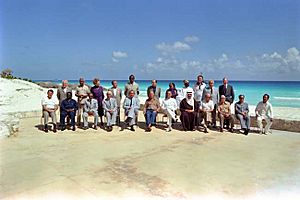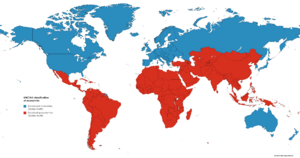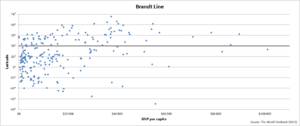Global North and Global South facts for kids
The Global North and Global South are terms used to group countries based on their wealth and how developed they are. They help us understand differences in how countries are doing economically and politically.
According to the UN Trade and Development (UNCTAD), the Global South mostly includes countries in Africa, Latin America and the Caribbean, Asia (except Israel, Japan, and South Korea), and Oceania (except Australia and New Zealand). Many countries in the Global South often have lower incomes, more poverty, fast-growing populations, not enough good housing, limited chances for education, and weaker health systems. Their cities also often have poor infrastructure, like roads and public services.
The Global North is the opposite. The UNCTAD says it mainly includes Northern America and Europe, Israel, Japan, South Korea, Australia, and New Zealand. It's important to remember that these terms are not about whether a country is in the Northern Hemisphere or Southern Hemisphere on a map. For example, many Global South countries are in the Northern Hemisphere, and some Global North countries are in the Southern Hemisphere.
Simply put, the Global North is made up of the world's developed countries, while the Global South includes developing countries and least developed countries. The term "Global South" was first used as a more neutral way to describe countries that were once called "Third World" countries. Many Global South countries are still developing their industries or were once under colonialism (ruled by another country).
Countries in the Global North and Global South are often compared by their levels of wealth, economic growth, and how strong their democracy is. Global North countries tend to be richer, have less inequality, are more democratic, and are more peaceful. They can also export advanced products. In contrast, Global South countries are often poorer, have more inequality, are less democratic, and depend a lot on farming and raw materials. Some experts think that the gap between the Global North and Global South is getting smaller because of globalization (countries becoming more connected). Others disagree, saying the Global South has actually become poorer compared to the Global North.
Since World War II, countries in the Global South have started working together more, a trend called "South–South cooperation" (SSC). This cooperation aims to challenge the economic power of the North. It has grown because many factories and production jobs have moved from the Global North to the Global South. This has helped Global South countries like China grow their economies and industries, and it helps them become more independent after the colonial era.
Contents
What do Global North and Global South mean?

| 0.800–1.000 (very high) 0.700–0.799 (high) 0.550–0.699 (medium) | 0.350–0.549 (low) Data unavailable |
The terms "Global North" and "Global South" are not just about geography, like dividing the world at the equator. Instead, they describe economic and migration patterns in a world that is increasingly connected through global capitalism.
As mentioned, the Global North generally includes Northern America, Europe, Israel, Japan, South Korea, Australia, and New Zealand. The Global South generally includes Africa, Latin America and the Caribbean, most of Asia, and most of Oceania. Some experts, like sociologists Fran Collyer and Raewyn Connell, argue that Australia and New Zealand face similar challenges to Global South countries because they are far away and in the Southern Hemisphere.
The Global South is home to large countries like China, India, Indonesia, Brazil, and Pakistan. These, along with Nigeria and Mexico, are some of the biggest Southern states in terms of land and population.
The Global North is often used to mean developed countries, while the Global South means developing countries. Countries in the Global South often have lower incomes, high poverty, fast population growth, limited education, and weaker healthcare. Their cities also often have poor infrastructure. Global North economies are diverse, while Global South economies often rely heavily on agriculture.
How the terms developed


The term "global south" was first used in 1969 by Carl Oglesby. He wrote that centuries of "northern dominance" had created an unfair world. The term became much more popular in the early 21st century. It offered a less judgmental way to talk about countries than older terms like "Third World" or "Developing World."
The idea of grouping countries by their economic status started during the Cold War. The world was divided into East (the Soviet Union and China) and West (the United States and its allies). The term "Third World" appeared in 1952. It described countries that were not aligned with either the East or West, and were often former colonies and poor.
Countries of the "Third World" tried to work together. The 1955 Bandung Conference was an early meeting where these countries promoted staying neutral. This led to the first Non-Aligned Movement summit in 1961. At the same time, a way of thinking called "core" and "periphery" developed, which helped bring the terms "North" and "South" into international discussions.
In the 1970s, there were efforts to create a New International Economic Order between the North and South. After the Yom Kippur War in 1973, Arab oil-producing countries raised oil prices, causing a worldwide economic slowdown. Richer nations became more protective of their economies and gave less aid to less developed countries. Western banks stepped in with loans, but many countries couldn't pay them back. This led to policies called structural adjustment, where international organizations like the IMF gave more loans if countries made certain economic changes.
After the Cold War ended and the Soviet Union broke up, a simpler way to classify countries was needed. The terms "North" and "South" became more widely used.
The Brandt Line
The Brandt Line is a drawing that shows the North-South divide. It was suggested by Willy Brandt, a former leader of West Germany, in a 1980 report. This line roughly follows the 30th parallel north latitude. It passes between the United States and Mexico, north of Africa and the Middle East, then goes north over China and Mongolia, and dips south to include Japan, Australia, and New Zealand in the "Rich North." While the Brandt Line is now considered outdated, it's still a helpful way to see global inequalities.
How the term Global South is used
The term Global South helps countries in the southern part of the world work together on political, economic, social, and environmental issues. This teamwork is called South–South cooperation (SSC). It aims to help Global South countries develop and become more united, so they can have more influence in the world. The idea is that these countries will "assist each other in social, political, and economical development." This cooperation is based on respecting each country's independence and helping each other with shared challenges like population pressure, poverty, hunger, disease, and natural disasters. They also work together on issues like environmental protection and fighting HIV/AIDS.
Understanding development
"Development" means how a country changes and improves its economy and society. Economic development means progress in technology, moving from farming-based economies to industrial ones, and improving how people live.
Being part of the "North" usually means a country is developed, while being part of the "South" often means it is still developing. Countries in the South often lack advanced technology, have unstable politics, and their economies rely on selling raw materials to the North. This can make them dependent on the North and keep them from developing fully. The North is seen as economically advanced and industrial, while the South often represents former colonies that need international aid.
Experts like Jean Grugel say that three main things affect the economic development of Global South countries: how leaders act within and between countries, how countries in a region work together, and where countries fit into the global economy.
Why the divide exists
The differences between the North and South can be explained by history. Dependency theory looks at how colonial relationships made colonized territories poorer. This theory suggests that former colonies' economies are still set up to serve outside demands rather than their own people's needs. This can lead to more poverty and big differences between rich and poor within those countries.
Another idea, New Economic Geography, says that industries tend to gather in certain places to become more efficient and productive. This leads to higher wages. The North has more of these industry clusters, making its businesses more competitive. It's argued that only when wages in the North get very high will it become more profitable for businesses to move to the South, allowing the South to start developing more industries.
Related ideas
Many ideas are linked to the Global South. Since many Global South countries were once colonized by Global North countries, they face challenges in developing quickly. Dependency theorists believe that information and ideas often flow from the Global North first, which can create a Western bias.
After World War II, the U.S. tried to help developing countries financially through Modernization theory. This idea suggested that Global South countries could develop faster by adopting Western technology, ways of organizing, and science.
However, post-development theorists questioned this. They argue that not all developing countries need to follow Western ways. Instead, they should create their own development plans that fit their unique cultures and needs, without too much influence from global capitalism.
Challenges to the divide
The idea of a simple North-South divide has been questioned. Countries within the South are very different politically, economically, and demographically, making it hard to see them as one group. Globalization has also blurred the lines. For example, after China opened up its economy in 1978, growing cooperation in Asia has made the North less of the only economic power. The economic situation of the South has also become more varied. By 2015, most Global South nations (except the poorest 60) were catching up to the North in income and economic diversity.
However, some experts like Jason Hickel and Robert Wade argue that the Global South is not rising economically, and that global inequality between North and South has actually increased with globalization. Hickel suggests that the North takes far more resources from the South than it gives in aid.
While globalization has changed how international groups like the IMF and World Bank approach development, some still argue that nations and regional trade are very important. There are ongoing efforts to include the Global South more fully in the world economy.
The North-South divide also makes international efforts to protect the environment difficult. Economic differences lead to disagreements over climate change data and who should pay for solutions. Global South countries often don't trust Northern data and can't afford the technology to collect their own. This is a growing problem as new powers emerge. Solving environmental issues needs global teamwork, but the North and South often disagree, slowing down progress.
Debates about the term
Many experts prefer "Global South" over older terms like "developing countries" or "Third World" because it sounds less judgmental. Leigh Anne Duck, an editor of Global South magazine, says the term helps countries resist powerful forces that threaten their independence. Alvaro Mendez, who co-founded the Global South Unit at the London School of Economics, praises the term for empowering countries. He points out that by 2030, most of the world's middle-class will live in developing countries. The popularity of the term shows a shift from just focusing on development to recognizing the importance of global political relationships.
However, critics say the term is too broad and groups many different countries together. They argue it might hide the specific historical relationships and power differences between countries. It might also hide the wealth differences within countries, meaning rich people in the Global South might have more in common with rich people in the Global North, while poor people everywhere face similar struggles.
Scholar Anne Garland Mahler says that the term "Global South" also has a deeper meaning from the Cold War. In this sense, it refers to "spaces and peoples negatively impacted by contemporary capitalist globalization." This means there are "economic Souths" in the geographic North and "Norths" in the geographic South. This idea suggests a global political community where people who are negatively affected by globalization recognize their shared struggles.
The exact boundaries of the Global South are still debated. Some scholars say it's not a fixed idea. Others argue that grouping many different countries together can hide their unique histories and power imbalances.
Future development
Some economists believe that international free trade and easy flow of money between countries could reduce the North-South divide. This would allow developing countries to grow economically.
As some countries in the South develop quickly, they are also starting to provide aid to other Global South nations. Brazil, for example, gives a lot of aid (about $1 billion annually) and shares its own experiences and knowledge. This is seen as a new global model for cooperation.
The United Nations has also worked to reduce the divide through its Millennium Development Goals, which aimed to end extreme poverty, improve education and healthcare, promote gender equality, reduce child deaths, improve maternal health, fight diseases, ensure environmental sustainability, and build global partnerships. These goals were replaced in 2015 by 17 Sustainable Development Goals (SDGs), which are meant to be achieved by 2030.
Society and culture
Digital and technological divide
The global digital divide (the gap in access to technology) often matches the North-South divide. However, Internet use, especially broadband access, is growing very fast in Asia. This is partly because many Asian countries can skip older Internet technologies and build new ones, and their booming economies allow more people to get online.
Media representation
Mass media often compares the Global South to the North, which can make the divide seem bigger. Western media sometimes shows a simplified and biased view of developing countries, focusing too much on poverty and other negative images. This common coverage has created a stereotype that the "South" is behind in social and economic development compared to Western standards.
Mass media also affects what information people in developing countries receive. News often focuses on developed countries, creating an imbalance in the flow of information.
See also
- BRICS, CIVETS, MINT, VISTA
- East–West dichotomy
- First World
- Global East
- Global majority, roughly corresponding to Global South peoples
- Golden billion
- Group of 77
- Inglehart–Welzel cultural map of the world
- International Solar Alliance
- Non-Aligned Movement
- North–South Centre, an institution of the Council of Europe, awarding the North–South Prize
- North–South model, in economics theory
- North–South Summit, the only North–South summit ever held, with 22 heads of state and government taking part
- Northern and southern China
- Three-world model
- World-systems theory
Subregions of Global North
- Global Northwest
- North Atlantic
- North Pacific
Subregions of Global South
- Global Southeast





